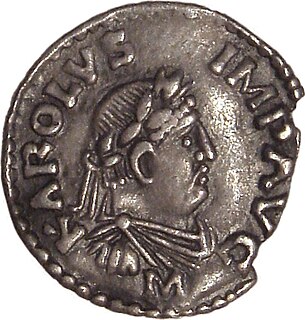
Saint Mihiel Abbey is an ancient Benedictine abbey situated in the town of Saint-Mihiel, near Verdun in the Meuse department in Lorraine in north-eastern France.

Saint-Mihiel is a commune in the Meuse department in Grand Est in north-eastern France.

Verdun is a small city in the Meuse department in Grand Est in northeastern France. It is an arrondissement of the department.

Meuse is a department in northeast France, named after the River Meuse. Meuse is part of the current region of Grand Est and is surrounded by the French departments of Ardennes, Marne, Haute-Marne, Vosges, Meurthe-et-Moselle, and has a short border with Belgium on the north. Parts of Meuse belong to Parc naturel régional de Lorraine. Front lines in trench warfare during World War I ran varying courses through the department and it hosted an important battle/offensive in 1916 in and around Verdun.
Contents
The benedictine abbey was built in 708 or 709 by a Count Wulfoalde and his wife Adalsinde, probably to house the relics that Wulfoalde had brought back from Italy. [1] It was dedicated to Saint Michael the Archangel, a popular saint at the time, as can be testified by the establishment of the abbeys of Mont St Michel in Normandy and the Abbey of Honau in Alsace in the same period. [2] In 1734 the tombs of both Wulfoalde and Adalsinde were discovered in the abbey. [3]

Michael is an archangel in Judaism, Christianity, and Islam. In Roman Catholic, Eastern Orthodox, Anglican, and Lutheran systems of faith, he is called "Saint Michael the Archangel" and "Saint Michael". In the Oriental Orthodox and Eastern Orthodox religions, he is called "Saint Michael the Taxiarch".. In other Protestant churches, he is simply called "Archangel Michael".

Alsace is a cultural and historical region in eastern France, on the west bank of the upper Rhine next to Germany and Switzerland.
The abbey was placed under the authority of Fulrad of St Denis, chaplain to Charlemagne. [4] In 755 a mayor Wulfoald, probably a relative of the founder of the abbey, was accused of high treason and plotting against Pepin the Short, was condemned to death. When Fulrad intervened to save his life, Wulfoald expressed his gratitude by giving King Childéric II his possessions, including the Abbey. [5]

Saint Fulrad was born in 710 into a wealthy family, and died on July 16, 784 as the Abbot of St. Denis. He was the counselor of both Pippin and Charlemagne. Historians see Fulrad as important due to his significance in the rise of the Frankish Kingdom, and the insight he gives into early Carolingian society. He was noted to have been always on the side on Charlemagne, especially during the attack from the Saxons on Regnum Francorum, and the Royal Mandatum. Other historians have taken a closer look at Fulrad's interactions with the papacy. When Fulrad was the counselor of Pepin he was closely in contact with the papacy to gain approval for Pepin's appoint as King of the Franks. During his time under Charlemagne, he had dealings with the papacy again for different reasons. When he became Abbot of St. Denis, Fulrad's life became important in the lives of distinct historical figures in various ways during his period as St. Denis's abbot during the mid-eighth century. Saint Fulrad's Feast Day is on July 16.

Charlemagne or Charles the Great, numbered Charles I, was king of the Franks from 768, king of the Lombards from 774, and emperor of the Romans from 800. During the Early Middle Ages, he united the majority of western and central Europe. He was the first recognised emperor to rule from western Europe since the fall of the Western Roman Empire three centuries earlier. The expanded Frankish state that Charlemagne founded is called the Carolingian Empire. He was later canonized by Antipope Paschal III.

Pepin the Short was the King of the Franks from 751 until his death. He was the first of the Carolingians to become king.
The Abbey is best known for its abbot Smaragdus, who moved there around the year 814 with his monks from the monastery on Mt. Castellion.
Smaragdus of Saint-Mihiel was a Benedictine monk of Saint Mihiel Abbey, near Verdun. He was a significant writer of homilies, and on the Rule of St Benedict.
Some time between 816 and 826 Smaragdus obtained royal protection for the abbey from Louis the Pious, ensuring that wagons, pack-horses and ships would be exempt from customs taxes on goods transported between the monastery and its lands. [6]

Louis the Pious, also called the Fair, and the Debonaire, was the King of the Franks and co-emperor with his father, Charlemagne, from 813. He was also King of Aquitaine from 781. As the only surviving adult son of Charlemagne and Hildegard, he became the sole ruler of the Franks after his father's death in 814, a position which he held until his death, save for the period 833–34, during which he was deposed.
Smaragdus achieved fame as a writer of homilies, and for his writings on the Rule of St Benedict.
Smaragdus, who died around 840, was succeeded as Abbott by Hadegaudus, who was probably elected by the monks themselves. [7]
Abbots in the tenth century included Odon I, followed by Sarovard, followed by Odon II, who died in 995.
Over the years, the abbey proved very popular with royalty, emperors and kings and dukes. In the 11th century, for example, it came under the protection of Gérard, Duke of Lorraine.
During the Middle Ages, the Abbey was famous for its relics, not least of which concerned Saint Anatole, Bishop of Cahors, whose body was reputed to have been transferred to Mihiel in 779. [8]
The Abbey was dissolved during the French revolution.











